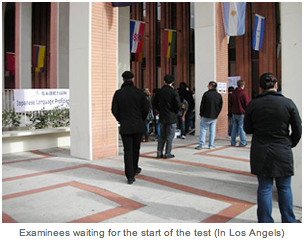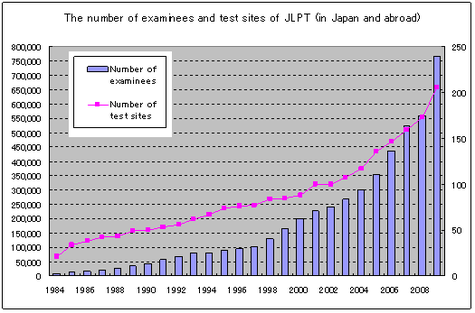Activity Reports:Japanese-Language Education Overseas:The Japanese-Language Proficiency Test (JLPT) Will Change! - Report on the JLPT in 2009 (December) and Information on New JLPT -
Center for Japanese-Language Testing
1. Report on the Japanese-Language Proficiency Test (JLPT) in 2009 (December)
On Sunday, December 6, 2009, the Japanese-Language Proficiency Test in 2009 (December) took place. It is a test to evaluate and certify the language proficiency of primarily non-native speakers of Japanese. The Japan Foundation has been administrating JLPT outside Japan with cooperation of local institutions. (The administrator of JLPT in Japan is Japan Educational Exchanges and Services, and in Taiwan is Interchange Association, Japan.)
Counting from the first test in 1984, it was the 27th because the test had been held once a year in December until 2008. In response to strong demands from within and outside Japan, however, the test is now held twice a year. The first test for 2009 was held in July only in Japan, South Korea, China (where five cities were added as new test sites) and Taiwan, and was limited to Level 1 and Level 2. The second test held in December was the first JLPT administered in Ireland, Serbia, and Columbia. In addition, the following cities were added as test sites: Yanji and Lanzhou in China and Da Nang in Vietnam.

The JLPT in 2009 (December) was held for Level 1 through 4 in 206 cities in 54 countries and regions. Approximately 610,000 applications were submitted in Japan and abroad, and about 520,000 examinees actually took the test. As the JLPT doubled the number of chances to take the test in one year, the number of examinees in 2009 reached around 770,000. We are very pleased to see that so many people took the opportunities to prove themselves.
Smooth administration of a test with such a huge number of examinees cannot be achieved without cooperation of local institutions in each country. Many people supported JLPT in preparation activities such as implementing public relations, receiving applications, arranging test sites, providing instructions to test supervisors, as well as in post-examination process, without mentioning the actual operation on the day of the test.
2. New Japanese-Language Proficiency Test
In recent years, test applicants became diversified, and use of JLPT results has expanded to include requirements for examinations for university entrance or professional certifications, employment screening and evaluation for promotions and pay raises. To ensure the continuing relevancy and accuracy of the JLPT, the Japan Foundation and Japan Educational Exchanges and Services will introduce a revised version of the test in 2010. This new test will take full advantage of the most advanced research in Japanese pedagogy and testing theory, and reflects the vast wealth of data accumulated for over a quarter of a century since the original JLPT was launched.
[Points of revision]
(For details, please visit the JLPT official website. Sample questions with audio are available.)
(1) Revised to measure communicative competence required to perform tasks.
Emphasizing both practical Japanese communicative competence and knowledge of the Japanese language, this test measures language knowledge which includes vocabulary and grammar, and the competence required to perform communicative tasks using such language knowledge.
(2) Revised to increase the number of levels from 4 to 5.
The new test increases the number of test levels from 4 (Level 1, Level 2, Level 3 and Level 4) to 5 (N1, N2, N3, N4 and N5) to allow the examinees to select the corresponding levels that are suitable for their ability.
(3) Revised to achieve score equating.
The scoring method was revised to ensure a more accurate measurement of Japanese-language proficiency. The new test uses "scaled scores," where the same competency gains the same score in any session by adopting an equating method.
(4) Revised to provide a Japanese-Language Proficiency Test Can-do List (tentative).
The new JLPT provides a "Japanese-Language Proficiency Test Can-do List" (tentative) to help examinees and others better understand the test results by presenting the level of practical language use that examinees who pass the test of each level are supposed to be capable of.
In 2010, the JLPT is scheduled to take place in Sunday, July 4 and Sunday, December 5. Registration for the test in July started in March 2010.
Related Articles
Back Issues
- 2025.9.30 The 51st Japan Found…
- 2025.9.30 The Japan Foundation…
- 2025.9.30 Bringing the World C…
- 2025.9.30 The 51st (2024) Japa…
- 2025.9.30 Japan Foundation Pri…
- 2024.5.24 The 50th Japan Found…
- 2024.3. 4 Movie Theaters aroun…
- 2023.4.10 The 49th Japan Found…
- 2023.3.28 JF's Initiatives for…
- 2023.1.27 Living Together with…


